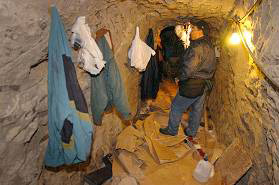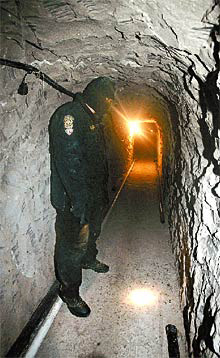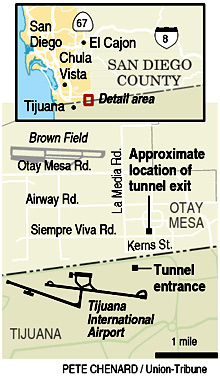 |
 |
 |
 News Around the Republic of Mexico | January 2006 News Around the Republic of Mexico | January 2006  
Two Tons of Pot Found Inside Mexico-US Border Tunnel
 Onell R. Soto & Leslie Berestein - Union-Tribune Onell R. Soto & Leslie Berestein - Union-Tribune


| | Investigators discovered a sophisticated cross-border tunnel yesterday extending about a half-mile and found about 2 tons of marijuana on the Mexican end. (David Maung) |
Investigators discovered a sophisticated cross-border tunnel yesterday extending about a half-mile and found about 2 tons of marijuana on the Mexican end.

The tunnel begins about 85 feet below a small warehouse about 175 yards south of the U.S. border. The other end is in an apparently vacant industrial building in Otay Mesa.

Late last night, authorities were still pulling marijuana out of the tunnel, which is outfitted with electricity and a ventilation system. The building is in an industrial neighborhood near Tijuana's airport.

The concrete-lined shaft is 6 feet by 12 feet with a metal ladder that leads to the packed-earth tunnel, which is tall enough for a person to stand in.

A gurney hanging from a pulley system attached to one of the building's beams allowed items to be moved into and out of the tunnel. Two trucks and a van were parked inside the warehouse.

Authorities said the elaborate tunnel bore the hallmarks of Mexican drug cartels, which have spent millions of dollars in the last 15 years to find a way to move contraband across the border.

When Mexican officials allowed the media into the small warehouse shortly before 9 p.m., reporters saw about 300 bundles of marijuana stacked more than 5 feet high.

In the United States, the warehouse where the tunnel ended north of Siempre Viva Road was surrounded by law enforcement agents last night.

Authorities did not estimate how long the tunnel might have been in use or provide information about who might own the properties where the tunnel's entrance and exit were found.


| | A Mexican federal agent investigated a tunnel below a small warehouse near Tijuana's airport last night. The tunnel, which extends a half-mile across the border into the United States, is outfitted with electricity and a ventilation system (Nancee E. Lewis) | 
| Going Underground
The biggest tunnels that U.S. and Mexican authorities have discovered under the border between California and Baja California:

Yesterday A 2,600-foot-long tunnel between an industrial building near Tijuana's airport and a warehouse near Siempre Viva Road in Otay Mesa.

Feb. 25, 2005 A 600-foot tunnel between a house in Mexicali and a house in Calexico.

Feb. 27, 2002 A 1,200-foot tunnel between a ranch house on the outskirts of Tecate, Mexico, and an unoccupied house in Tierra del Sol near Boulevard.

May 31, 1993 An unfinished 1,450-foot tunnel that began in an industrial building near Tijuana's airport. The tunnelers were headed toward a warehouse on Siempre Viva Road in Otay Mesa, but were about 120 feet short when it was discovered. |
In Tijuana, after spending most of yesterday waiting for a search warrant from Mexico City, dozens of Mexican police and federal agents swarmed around the metal building and surrounding truck yard late in the afternoon.

While Mexican agents awaited approval for a thorough search of the shaft, their U.S. counterparts resumed digging with heavy equipment in an area between two border fences.

That digging stopped about 4:15 p.m. when word came back that Mexican agents had found the tunnel at the bottom of the shaft.

"We have a tunnel and it's massive," said Lauren Mack, a spokeswoman with U.S. Immigration and Customs Enforcement, which was investigating the tunnel with agents from the Border Patrol and the Drug Enforcement Administration.

The U.S. Attorney's Office in San Diego and Mexican federal, state and local officials are also part of the investigation.

Based on tips, U.S. officials began investigating the possibility of a tunnel in the area in 2004.

The investigation included searches using high-tech equipment capable of providing rough images of objects underground.

Monday evening, U.S. agents notified their Mexican counterparts of the possibility of a tunnel.

California National Guard troops who work with the Border Patrol began digging Tuesday morning with a bulldozer and a backhoe.

In Tijuana, Mexican military trucks rolled in and out of the yard yesterday.

At a billboard-making business next door, worker José Javier Ramirez Velasquez, 24, said the large shed "appeared abandoned."

Since moving from Guadalajara two months ago, he has been staying on a trailer nearby and said he had heard no noise or any digging.

"It caught me by surprise learning there was a narcotunnel here," he said. Meanwhile, several miles away yesterday morning, a U.S. Border Patrol agent found another tunnel a short distance west of the San Ysidro border crossing.

This tunnel, far from sophisticated, is the kind that agents call a "gopher hole." It was dug in an area just south of the fence in Mexico and extended about 30 feet in the United States, officials from Immigration and Customs Enforcement and the Border Patrol said.

The tunnel, just 2 feet underground and about 2 feet square, was discovered after an agent investigating some people standing near the fence north of the border found an area where it had caved in, Border Patrol spokesman Richard Kite said.

"It was not a complete tunnel and was of no use to any criminal enterprise," he said. "There were several people who were coming north of the fence. One of them was able to make it back across to Mexico."

That tunnel was about 50 yards west of where a similar tunnel was found Jan. 9.

A fourth tunnel under construction, with electric lights but with its entrance covered by a board, was discovered near the Otay Mesa border crossing Friday.

This month's discoveries bring to 21 the number of tunnels found in Arizona and California since Sept. 11, 2001, when inspections at the border crossings were beefed up. Between 1990 and 2001, 15 tunnels were found.

The increased number of tunnels is a good sign, said John Fernandes, the special agent in charge of the DEA's San Diego office.

"It is an indication, as far as I'm concerned, about their frustration with our success," he said.

Drug seizures at California border crossings were up 24 percent last fiscal year over the year before, customs officials announced this week. In the year ending Sept. 30, more than 127 tons of drugs were seized, the vast majority of that marijuana.

Tunnels provide a way to avoid inspectors altogether, and that's why drug cartels will spend millions of dollars building them, said lawyer John Kirby, who specialized in drug prosecutions before leaving the U.S. Attorney's Office last year.

"You don't have to play Russian roulette with the border," he said.

The Arellano-Felix cartel was behind a 1,000-foot tunnel between a Mexican ranch house east of Tecate and a house in East County.

It has been battling rival cartels headed by accused drug traffickers Ismael "El Mayo" Zambada and Joaquín "El Chapo" Guzman.

Guzman has tried underground routes before, prosecutors said.

In 1993, people working for him tried to dig a tunnel 1,450 feet north from an industrial building in Tijuana to a factory building under construction in Otay Mesa. They came up in a field about 120 feet short of their target.

That tunnel was discovered after officials found a map in a Tijuana safe house while investigating the killings of Cardinal Juan José Posadas Ocampo and six others in Guadalajara.

Guzman was caught, but escaped from a Mexican jail in 2001. He was indicted in San Diego on drug-trafficking charges. U.S. authorities have offered a $5 million reward for information relating to his arrest.

"Chapo was known," Kirby said. "He could get drugs over quickly."

Onell Soto: (619) 293-1280; onell.soto@uniontrib.com | 
 | |
 |



